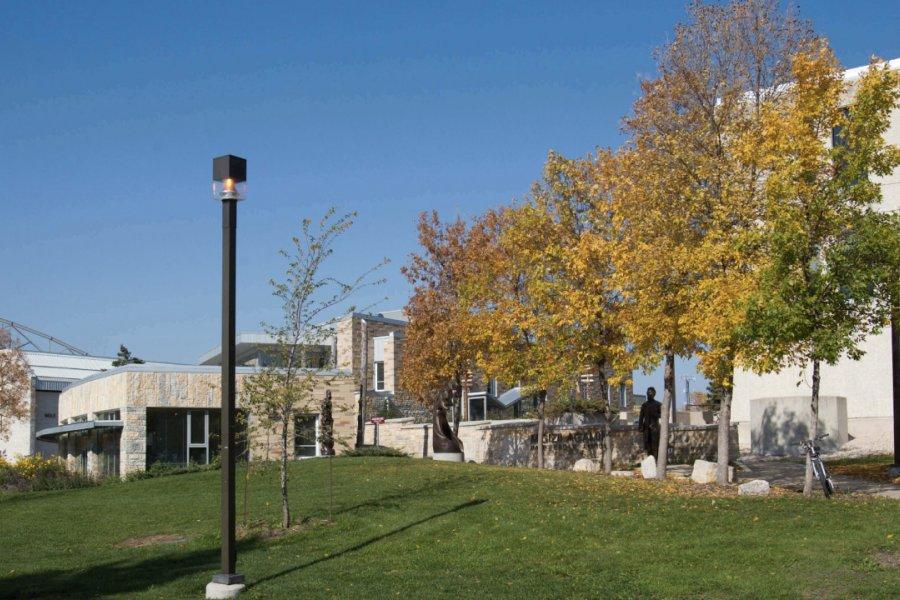
Build your skills with Microsoft Teams
Knowing how to use Teams effectively can make working remotely easier. You can build your ability to implement Teams within your own team in two easy steps. It should take 15-20 minutes to work through this material.
Step 1: Sign in and get started
Access Teams through a browser or download and install the Teams app.
You can access and use Teams either from your browser or from the App on your computer or mobile device.
Some of the functionality of Teams is not supported in all browsers. The recommended browsers for use with Teams are Google Chrome or the latest version of Microsoft Edge.
Installing the Teams app will guarantee you full functionality. Note: Administrative access may be required to install the software.
Whether you are using a browser or the app, sign in to Teams using your @umanitoba.ca or @myumanitoba.ca email and password.
Step 2: Set up your team
Creating your team, inviting members, and setting up channels effectively is the first step in organizing the conversations and work you participate in daily. Once created, you can go further by using your team to share files and meeting notes in a centralized way.
How to create a team, invite co-workers, and set-up channels
It is helpful to think of a team as a group of people you’d like to work with on a specific project or subject, while a channel is more specific, and dedicated to different topics beneath the overall subject.
Conversations in channels can be seen and searched for by the entire team. You can participate in conversations, like or save important ones, mention specific people so they see your message, and even edit a file that’s been added to the conversation.
How to invite a person from outside of UM to a Teams meeting
Faculty, staff and students with a Microsoft 365 license can:
- Invite people outside of your organization to a Teams meeting with another email address.
- Add people who do not have a @umanitoba.ca or @myumanitoba.ca email address as a “guest” to any Team you create. Once they are a guest in a Team, you can invite them to a meeting, collaborate, chat and share files in a channel.
Learn how to invite someone from OUTSIDE of your organization to a Teams meeting:
- Invite anyone from outside of your organization to your meeting
- How to join a Teams meeting you were invited to as a Guest
How to upload and share files
You can easily share files with your coworkers with Teams, ensuring that everyone is working with the most recent version and giving yourself the ability to edit documents together.
How to add OneNote to a Teams channel
You can setup a OneNote notebook as a new Tab in a Teams channel. OneNote can be a useful tool for keeping and organizing meeting notes.
Step 3: Learn how to chat and call effectively
Before you used Microsoft Teams, you may have been familiar with other chat and conferencing tools, such as WebEx or Skype. You might have used these to host a video conference or share your screen to review work with others. Use the resources below to learn how to perform these functions in Teams and what Teams can do beyond that basic functionality.
How to chat and call
Want to talk to a person or small group? You can use teams to collaborate with a smaller group or to talk privately. You can chat or do audio and video calls, and easily add another person to the conversation in real-time.
Learning how to use the command box (search box) is a great way to find people quickly.
How to manage meetings
Teams syncs with your Outlook calendar and allows you to set up new meetings, accept meetings you’ve been invited to, and join a Teams call for scheduled meetings.
Additional video conferencing resources from UM:
How to show your screen during calls
In Microsoft Teams, you can show your desktop, a specific app, presentation, or any file while in a meeting.
If you’re sharing a PowerPoint presentation, share the file directly instead of the traditional way of sharing your screen. This will allow others to navigate through the deck at their own pace without interrupting you.
How to multitask
You can keep working even while you're in a meeting. You won’t drop the call or lose the ability to be heard or seen.
Step 4: Learn how to add your own virtual background
Adding a virtual background in Teams is a great way to customize your meeting experience.
You can change your background before or during a meeting. Follow the instructions below for adding a background to Teams:
Before joining a meeting
Before clicking the “Join now” button:
- Click the Background effects button next to the mic switch. Your background options will display on the right.
- Choose Add New and browse your computer to find the UM background images.
- Select an image, click Open.
During a meeting
- From the meeting controls, click the “... ” More actions button.
- Select Apply background effects to display the background options on the right.
- Choose Add New and browse your computer to find the UM background images.
- Select an image, click Open then Apply.
UM virtual backgrounds available for download
The University of Manitoba has created virtual backgrounds for use with Microsoft Teams meetings.
You may also be interested in
Contact us
Call or chat
Monday to Friday, 8 a.m. to 8 p.m.
Call 204-474-8600 or use our new 'Chat with us' bubble at the bottom right corner of this site for a faster response via text or call.
To report a critical system outage after hours or on weekends and holidays, call 204-474-8600 and press 2.
IST Service Desk walk-in service
123 Fletcher Argue
University of Manitoba, Fort Garry
Hours: Monday to Friday, 8 a.m. to 6 p.m.
Join the queue: Fort Garry WaitWell
230 Neil John Maclean Library
University of Manitoba, Bannatyne
Hours: Monday to Friday, 8 a.m. to 4:30 p.m.
Join the queue: Bannatyne WaitWell












